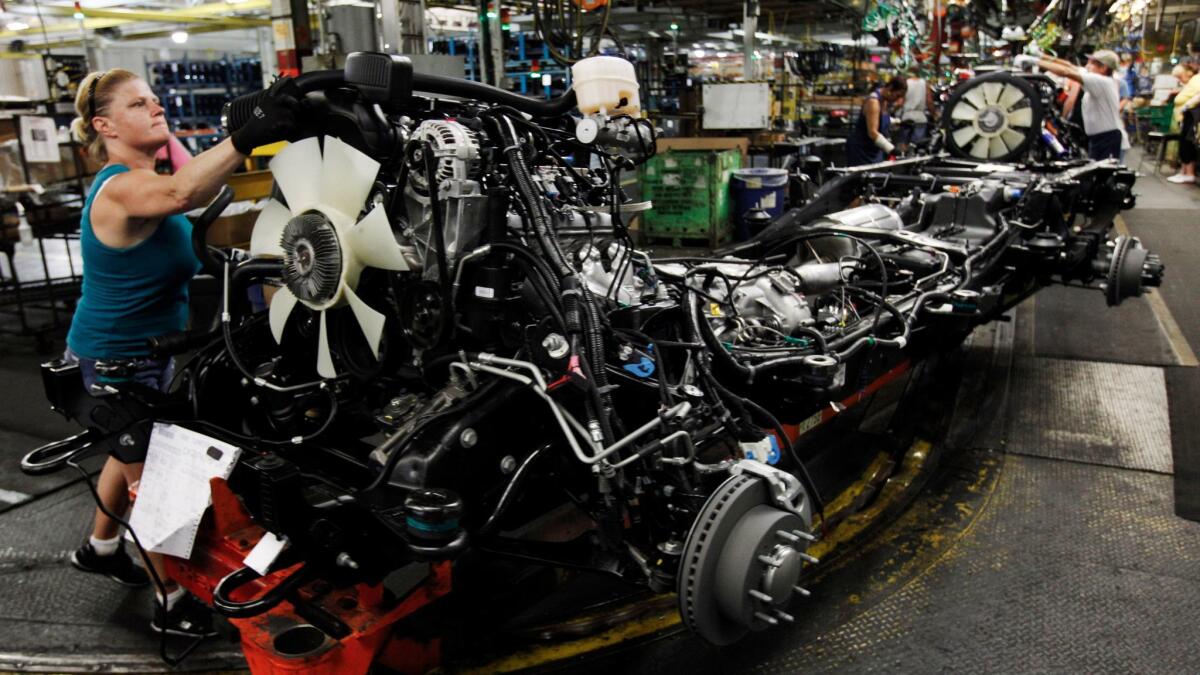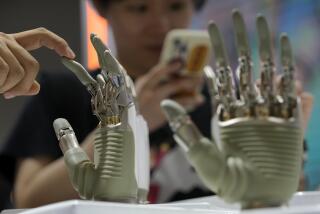Op-Ed: Populists want to bring back the blue-collar Golden Age. But was it really so golden?

Thanks to Donald Trump’s populist rhetoric, the most romanticized figure in America right now is the blue-collar worker of yesteryear — symbol of an era in which companies took good care of their front-line employees. Just listen to the way Steve Bannon, the White House chief strategist, talks about his dad, Marty, who scampered up telephone poles for AT&T in the 1950s.
“His job was everything, but his paycheck was a way to be part of civic society,” the younger Bannon told the Wall Street Journal. “As a child he never talked at all about how high the AT&T stock was. It was the Little League season or the charity event at the church or the May queen.”
“Why can’t you revert back to a Golden Age?” he asked.
It is a fine question, though one that depends on a simplistic understanding of the past.
For tens of millions of workers across the nation, the postwar period was indeed golden in many respects. From the late 1940s through the early 1970s, pay and benefits for more than three-fourths of the nation’s labor force surged by 90%. Since then, compensation for this huge swath of the population has been more or less flat—a raise of about 10% over 40 years, after adjusting for inflation.
Many work environments are far less punishing than they were 50 or 60 years ago.
Job security was also far stronger than it is today, even for those with few skills or little education. Although it wasn’t uncommon for factory hands to be laid off because of seasonal fluctuations, they could count on being rehired as soon as work picked up again. “Downsizing” wouldn’t enter the American vernacular until the 1980s.
But that’s only part of the story.
The workers who did well during the Golden Age were white and male. For women and people of color, corporate America was openly hostile. (In many cases, it still is.)
About a quarter of the nation’s population lived in poverty during the Golden Age, causing John Kenneth Galbraith, in his 1958 book “The Affluent Society,” to express grave concern about those suffering from “inequality and deprivation.”
And as Yale University researchers found when they interviewed hundreds of GM workers in the early 1950s, even those lucky enough to land good jobs in America’s manufacturing plants quickly learned that they could be brutal places to work.
In many sections of the factory, the din was continuous and the air polluted, contaminated by oil and smoke. “Here, look at my cap,” said Stanley Tomsky, a metal finisher at a General Motors factory in Linden, N.J., holding up a hat full of steel dust. “Imagine what my lungs are like.”
When production workers at GM needed a break, managers were supposed to dispatch “relief men” into position to keep the line moving. But “you can’t get relief until they see the piss running out of your eyeballs,” said Robert Scales, a glass installer.
Men went home irritable, exhausted. “I can’t go bowling or shoot pool anymore,” said John Hajducsek, a 38-year-old seat-installation man who was hired by GM in 1940. “I have no energy to go out. As far as I’m concerned, I’m finished.”
The reality is that most blue-collar jobs in postwar America were directed by top-down management structures that pushed many workers to the physical and mental brink.
In the coming decades, these conditions would by and large improve.
This is not to discount the degradation and dangers that many still face on a daily basis—in meatpacking plants, auto-parts manufacturers and other factories. Nor is it to downplay the terrible circumstances confronted by legions of Americans in low-end service jobs: wage theft, the manipulation of their schedules and other forms of exploitation.
Indisputably, however, many work environments are far less punishing than they were 50 or 60 years ago. And in many instances, the work itself has gotten more interesting.
Among America’s best companies, it’s conventional wisdom that managers should not “foster we/they labor attitudes” and instead see every worker “as a source of ideas,” as Tom Peters and Bob Waterman wrote in their bestseller from 1982, “In Search of Excellence.”
By the early 1990s, according to surveys, more than a third of businesses had backed away from using strict command-and-control methods and moved toward more flexible arrangements, like self-governing teams. That trend has continued.
The cruel paradox—and the reason Trumpist populism is on the rise— is that this leap forward in workplace models came at the very same time that most blue-collar employees and many others stopped seeing economic gains. Managers may be more enlightened in some ways, but other, more concrete aspects of the employer-employee compact have fallen apart.
“Many workers have been empowered to play a greater role in designing their jobs,” MIT’s Paul Osterman observed 20 years ago, but “wage levels have stagnated … and employment security is eroding.”
It’s easy to talk of going back to a Golden Age, but the real trick for policy-makers and executives will be to make all of these pieces come together at once: good pay, benefits and job security for the working class, along with dignity and fulfillment in what they do.
Rick Wartzman is the author of “The End of Loyalty: The Rise and Fall of Good Jobs in America.”
Follow the Opinion section on Twitter @latimesopinion or Facebook
More to Read
A cure for the common opinion
Get thought-provoking perspectives with our weekly newsletter.
You may occasionally receive promotional content from the Los Angeles Times.










